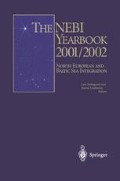Abstract
A rather basic and crude analysis of the development of the armed forces of the three Baltic States since independence in 1991 would point to three crucial factors: Russia, money and will. The legacy of Russian/Soviet occupation continues to weigh heavily on the minds of the Baltic States, and though not explicitly stated in their respective national security policy documents, Russia is still regarded as a source of potential danger. The question of money is a critical one, particularly in the coming five years. Economic resources are limited and all sectors of the developing market economies have demands. The avowed goal of a defence budget of 2 per cent of national GDP is crucial to the further development of the armed forces, and the linchpin of their preparations for membership in the North Atlantic Alliance. Given the limited economic resources and the `Russian factor,’ it is not surprising that political and national consensus on the issue of developing the national armed forces is not complete. Disagreement focuses on the question of money, which derives from the question of priorities. Should the priority be membership in NATO, or good neighbourly relations (read Russia)? Further strains are evident in the way in which armed forces should be developed — what kind of defence force should they have?
The author would like to thank officials at the Embassy of the Republic of Latvia in Stockholm, the Swedish Ministry of Foreign Affairs, the Finnish Ministry of Defence, and the Danish Military Attaché to Estonia for their assistance in preparing this chapter. Additional thanks for critical comments are due to Erik Männik, former head of Plans & Policy at the Estonian MoD, Pertti Joenniemi and Olav E Knudsen.
Access this chapter
Tax calculation will be finalised at checkout
Purchases are for personal use only
Preview
Unable to display preview. Download preview PDF.
References
The Baltic Times (1997). ‘Baltic Militaries look for answers,’ 3-9 April.
Clemmesen, M. (1998). ‘Foreign military assistance,’ pages 227 - 58 in Mouritzen, H. (ed.). Bor-dering Russia: Theory and Prospects for Europe’s Baltic Rim. Aldershot, England, Ashgate.
Estonia Today (1998). ‘The Defence Forces,’ 18 December. Tallinn, Ministry of Foreign Affairs.
Estonia Today (2000). ‘Basic Facts on the Estonian Defence Forces,’ 15 November. Tallinn, Min-istry of Foreign Affairs.
Haab, M. (1995). ‘Estonia and Europe: security and defence,’ in Van Ham, Peter (ed.) The Baltic States: Security and defence after independence, Chaillot Paper 19, June 5995, Institute for Security Studies Western European Union.
Jauhiainen, J. (1999). ‘The Conversion of Military Areas in the Baltic States,’ pages 327-334, in Hedegaard, L. and Lindström, B. (eds). The NEBI Yearbook 1999 North European and Baltic Sea Integration. Berlin, Heidelberg, Springer.
Keesing’s Record ofWorld Events (2000a). Estonia, page 43643, Volume 46, No. 6, June. Washington DC, Keesing’s Worldwide.
Keesing’s Record ofWorld Events (2000b). Estonia, page 43713, Volume 46, No. 7/8, August. Washington DC, Keesing’s Worldwide.
Keesing’s Record of World Events (2000c). Estonia, page 43764, Volume 46, No. 9, September. Washington DC, Keesing’s Worldwide.
Lindstöm, L. (1997). ‘Estonia’s view of military co-operation and its prospects in the Baltic Sea Region,’ pages 85-93 in Military Co-operation and Its Prospects in the Baltic Sea Region, Research Report, Series 2, No. i. Helsinki, National Defence College, Department of Strategic Studies.
Military Balance (1993-2000). Royal Institute for Strategic Studies. Oxford, Oxford University Press.
Ministry of Defence (1997). Security Concept of the Republic of Latvia Mimeo.
Ministry of Defence (1990. Defence White Paper. Ministry of Defence of the Republic of Lithuania. Available at http://www.kam.lt
Ministry of Defence (2000a). White Paper 2000,‘Report of the Minister of Defence of the Republic of Latvia to the Parliament on State Defence policy and Armed Forces Development for the year 2000.’
Ministry of Defence (2000b). Trends of theDefence Budget for 1999-2003 , Ministry of Defence of the Republic of Latvia. http://www.mod.lv/english/sec_bugets/1999-zoo3.htmhttp://www.vm.ee/eng/estoday/z000/defence-facts.htm
Nordberg, E. (1994). The Baltic Republics: A strategic survey, Finnish Defence Studies, No. 6. Helsinki, National Defence College.
RFE/RL (z000a). Radio Free Europe/Radio Liberty, Baltic States Report,Vol. 1, No. 33, 16 October.
RFE/RL (z000b). Radio Free Europe/Radio Liberty, Baltic States Report,Vol. 1, No. 35, 20 November.
RFE/RL (z000c). Radio Free Europe/Radio Liberty, Baltic States Report, Vol. 1, No. 37, 5 December.
RFE/RL (zoo,). Radio Free Europe/Radio Liberty, Baltic States Report,Vol. 1 No. 39, 10 January. SIPRI Yearbook: Armament, Disarmaments and International Security (1993-1999). Stockholm International Peace Research Institute. Oxford, Oxford University Press.
Editor information
Editors and Affiliations
Rights and permissions
Copyright information
© 2002 Springer-Verlag Berlin Heidelberg
About this chapter
Cite this chapter
Jones, C. (2002). The Development of the Armed Forces in the Baltic States. In: Hedegaard, L., Lindström, B., Joenniemi, P., Östhol, A., Peschel, K., Stålvant, CE. (eds) The NEBI YEARBOOK 2001/2002. Springer, Berlin, Heidelberg. https://doi.org/10.1007/978-3-662-13181-7_16
Download citation
DOI: https://doi.org/10.1007/978-3-662-13181-7_16
Publisher Name: Springer, Berlin, Heidelberg
Print ISBN: 978-3-642-07700-5
Online ISBN: 978-3-662-13181-7
eBook Packages: Springer Book Archive

